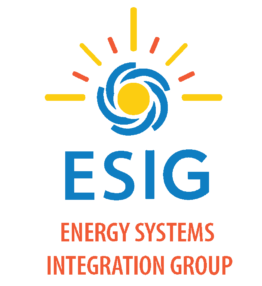The Ralph O’Connor Sustainable Energy Institute (ROSEI) at Johns Hopkins University (JHU) has recently become a member of the Energy Systems Integration Group (ESIG), a leading international group of industry and researchers working on grid integration of renewable energy, with a focus on improved forecasting and electricity market design.
 ESIG, founded as the Utility Wind Integration Group, is also a top source of global expertise for wind and solar operations and power system integration.
ESIG, founded as the Utility Wind Integration Group, is also a top source of global expertise for wind and solar operations and power system integration.
“This new linkage between ESIG and ROSEI will raise JHU’s visibility and influence in the areas of market design, uncertainty management, and other issues involved in integrating the coming wave of variable, uncertain, and inverter-based solar and wind powered devices,” said Benjamin Hobbs, a ROSEI leadership council member and one of the institute’s leaders of its grid research pillar. “This higher profile for JHU will also enhance the attractiveness to others of making JHU a partner in research and implementation efforts.” Hobbs is the Theodore M. and Kay W. Schad Professor of Environmental Management in Johns Hopkins’ Department of Environmental Health and Engineering.
ROSEI’s researchers can now participate in ESIG task forces, conferences, and workshops. Enrique Mallada, a ROSEI-associated researcher who is also a leader of the institute’s grid pillar, is excited about the opportunity for the institute’s affiliated researchers to collaborate via ESIG working groups, which aim to assess solutions to the challenges presented by the energy transition.
“Particularly, with respect to the grid pillar, I am looking forward to access to the working groups on System Operation and Market Design, and Reliability. Joining these groups, and their task forces, will allow the research developed in the grid initiative to have a direct impact on the industry,” said Mallada, an associate professor in the Whiting School of Engineering’s Department of Electrical and Computer Engineering.
Incoming Hopkins faculty member and ROSEI affiliated researcher Sijia Geng recently attended the ESIG 2022 Fall Technical Workshop and is pleased that ROSEI had joined the organization.
“I thoroughly enjoyed my discussions with industry leaders from around the world during the workshop, and I think being a member of ESIG will enable researchers at ROSEI to have regular conversations like those. Such a platform will benefit grid experts at ROSEI to zoom in and prioritize pressing issues real-world energy systems are experiencing,” Geng said. “I also think ROSEI can bring future-looking research to ESIG and help the industry develop analytical tools and cutting-edge technologies. Our experts can also offer curriculum design for professional education and K-12 education to ESIG, too.”
Yury Dvorkin, a ROSEI core faculty member who is also a leader of the institute’s grid pillar, also believes the partnership will lead to opportunities for students to get workforce training, with ample opportunity for establishing mentorships through connections that otherwise would have been more difficult to make.
Dennice Gayme, a ROSEI leadership council member, and a leader of the institute’s wind pillar, says the ESIG-ROSEI partnership will benefit the ROSEI’s wind energy pillar, as well. In her view, the connection will give ROSEI a stronger connection to the community discussing wind integration, strongly linking the institute’s grid integration of wind efforts with those of the larger community.
“For our wind energy work, particularly the controls work, this membership gives us a platform that we can use to help inform the community of what is possible in terms of a wind farm interacting with the grid,” said Gayme, who is an associate professor of mechanical engineering and the Carol Croft Linde Faculty Scholar. “Interactions between wind energy and grid researchers is critical to improve the efficiency and impact in both areas of research. Wind researchers need to be more grid aware and grid researchers need to understand the potential of wind in terms of helping with grid services.”